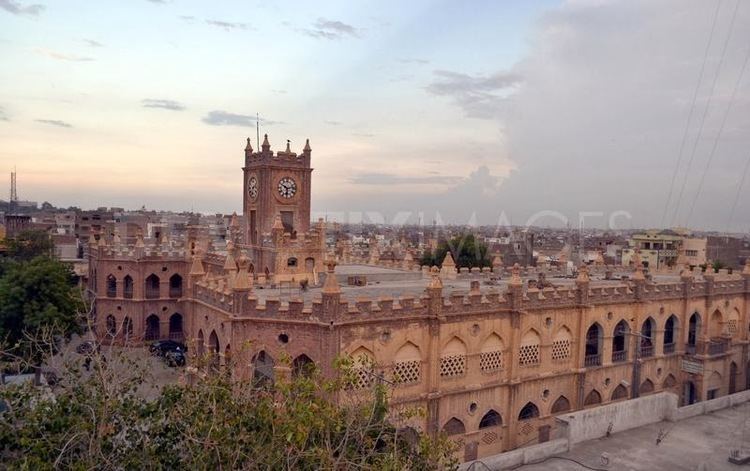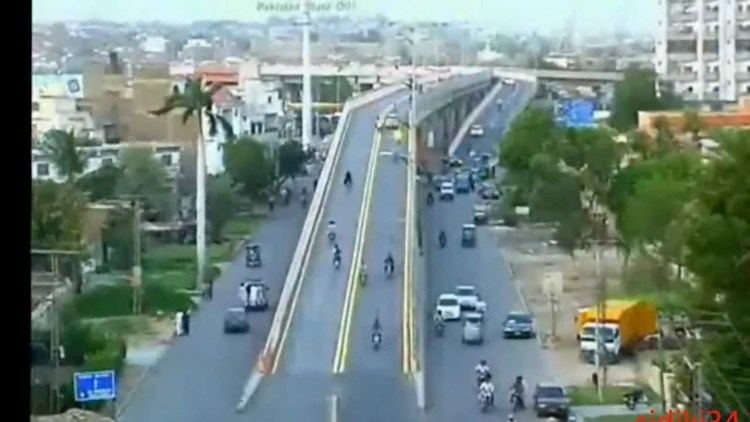Country | Founded 1768 Area 3,198 km2 | |
 | ||
Colleges and Universities Superior College of Science, Govt Shah Latif Girls College, Hiast College Institute of Arts and Science, University of East, Model School Sindh University Old Campus | ||
Map of Hyderabad, Sindh
Hyderabad (Sindhi and Urdu: حيدرآباد Ḥaidarābād) is a city located in Sindh province of southern Pakistan. Hyderabad is the 6th largest city in Pakistan and the 2nd largest in the province of Sindh.
Contents
- Map of Hyderabad Sindh
- New look city hyderabad sindh pakistan cities hyderabad vs hyderabad
- Hyderabad sindh pakistan drivethrough 20 mins sam 1184
- Early
- Founding
- Capital of Sindh
- Demographics
- Geography and climate
- Economy
- Administrative divisions
- Points of interest
- Literature
- Radio and television
- Notable people
- References

New look city hyderabad sindh pakistan cities hyderabad vs hyderabad
Hyderabad sindh pakistan drivethrough 20 mins sam 1184
Early

In 711 CE, Arab general Muhammad bin Qasim conquered Sindh, bringing South Asian societies into contact with Islam. Raja Dahir was a Hindu king who ruled over a Buddhist majority and that Chach of Alor and his kin were regarded as usurpers of the earlier Buddhist Rai Dynasty. This view is questioned by those who note the diffuse and blurred nature of Hindu and Buddhist practices in the region, especially that of royalty to be patrons of both and those who believe that Chach himself may have been a Buddhist. The forces of Muhammad bin Qasim defeated Raja Dahir.
Founding
Mian Ghulam Shah Kalhoro of the Kalhora Dynasty founded the city in 1768 over the ruins of Neroon Kot (Nerun or Nerun Kot meaning the place of Neroon), a small fishing village on the banks of Indus River named after its ruler Neroon. A formal concept for the city was laid out by his son, Sarfraz Khan in 1782. When the foundations were laid, the city obtained the nickname Heart of the Mehran as the ruler Mian Ghulam Shah himself was said to have fallen in love with the city. In 1768 he ordered a fort to be built on one of the three hills of Hyderabad to house and defend his people. The fort was built using fire-baked bricks, on account of which it was named Pacco Qillo (Sindhi: پڪو قلعو) meaning the strong fort.
The City has a history of Sufism. In the 18th Century Syeds from Multan migrated and settled at Tando Jahania making it a sacred place for Muslims. These Syeds came here from Uch Sharif (Bahawalpur District) via Jahanian (Khanewal District 42 km from Multan). These were the descendants of Jahaniyan Jahangasht a noted Sufi saint.
Capital of Sindh
The City of Hyderabad served as the capital of Sindh province, From 1947 to 1955, which was later dissolved and one unit was formed named West PakistanCity also served as capital during Kalhoro regime
Demographics
Hyderabad is noteworthy in Sindh and Pakistan generally for its comparative tolerance towards religious and ethnic minorities. The city is a multi-ethnic and has a mix of Sindhi, Urdu speaking Muhajirs, Brahuis, Punjabis, Pashtuns, Memons and Baloch people.
The independence of Pakistan in 1947 saw the influx of Muslim Urdu-speaking Muhajirs from India fleeing from anti-Muslim pogroms. Mahjirs mainly live in Latifabad and Sindhi mainly live in Qasimabad areas.
A large influx of Punjabis were attracted to Hyderabad after the Indus treaty settlement. Most Punjabis and Pakhtuns are distinct and separately living near the railway station and its vicinity. The city therefore has cosmopolitan atmosphere with multiethnic and multicultural communities.
Hindus account for the largest religious minority forming 5% of the total population of the city. While Christians account for 1% of the total population, Hyderabad is the seat of a Diocese of the Church of Pakistan and has five churches and a cathedral.
Geography and climate
Located at 25.367 °N latitude and 68.367 °E longitude with an elevation of 13 metres (43 ft), Hyderabad is located on the east bank of the Indus River and is roughly 150 kilometres (93 mi) away from Karachi, the provincial capital. Two of Pakistan's largest highways, the Indus Highway and the National Highway join at Hyderabad. Several towns surrounding the city include Kotri at 6.7 kilometres (4.2 mi), Jamshoro at 8.1 kilometres (5.0 mi), Hattri at 5.0 kilometres (3.1 mi) and Husri at 7.5 kilometres (4.7 mi).
Hyderabad has a hot desert climate (Köppen BWh), with warm conditions year-round. The period from mid-April to late June (before the onset of the monsoon) is the hottest of the year, with highs peaking in May at 41.4 °C (106.5 °F). During this time, winds that blow usually bring along clouds of dust, and people prefer staying indoors in the daytime, while the breeze that flows at night is more pleasant. Winters are warm, with highs around 25 °C (77 °F), though lows can often drop below 10 °C (50 °F) at night. The highest temperature of 48.5 °C (119 °F) was recorded on 7 June 1991, while the lowest temperature of 1 °C (34 °F) was recorded on 8 February 2012.
In recent years, Hyderabad has seen great downpours. In February 2003, Hyderabad received 105 millimetres (4.13 in) of rain in 12 hours, leaving many dead. The years of 2006 and 2007 saw close contenders to this record rain with death tolls estimated in the hundreds. The highest single-day rain total of 250.7 millimetres (9.87 in) was recorded on 12 September 1962, while the wettest month was September 1962, at 286 millimetres (11.26 in).
Economy
Hyderabad is an important commercial centre where industries includes: textiles, sugar, cement, manufacturing of mirror, soap, ice, paper, pottery, plastics, tanneries, hosiery mills and film. There are hide tanneries and sawmills. Handicraft industries, including silver and gold work, lacquer ware, ornamented silks, and embroidered leather saddles, are also well established. Hyderabad produces almost all of the ornamental glass bangles in Pakistan. Hyderabad is a major commercial centre for the agricultural produce of the surrounding area, including millet, rice, wheat, cotton, and fruit.
Administrative divisions
Before the government of Abubaker Nizamani, the District Hyderabad included the present-day District of Badin. Then in the 2005-6 General Pervaiz Musharraf again divided it into four more districts Matiyari, Tando Allahyar, Tando Mohammad Khan and Hyderabad. Hyderabad district was subdivided into four talukas
- Hyderabad City Taluka
- Hyderabad Taluka (rural)
- Latifabad
- Qasimabad
Points of interest
Literature
As tradition goes, Sindh had always been a hub for Sufi poets. With a foothold on strong educational foundations, the city of Hyderabad was made into a refuge for thriving literary advocates. Of the few, Mirza Kalich Beg received education from the Government High School, Hyderabad and carried the banner of Sindhi literature across borders. Modern novelists, writers, columnists and researchers like Musharraf Ali Farooqi, Ghulam Mustafa Khan and Qabil Ajmeri also hail from Hyderabad.
Hyderabad has served many Sindhi literary campaigns throughout the history of Pakistan as is evident from the daily newspapers and periodicals that are published in the city. A few worth mention dailies are the Kawish, Ibrat, and Daily Sindh.
Radio and television
With the inauguration of a new broadcasting house at Karachi in 1950, it was possible to lay the foundations for the Hyderabad radio station in 1951. The initial broadcast was made capable using 1 kW medium-wave transmitter. With the first successful transmissions on the FM 100 bandwidth in Karachi, Lahore and Islamabad in October 1998, the Government decided on opening transmissions to other cities where Radio Pakistan had found success. This made available the FM 101 bandwidth transmissions to Hyderabad and other cities in Sindh.
A relief from the regular broadcasts in other cities, entertainment content on the Hyderabad radio gave birth to many a star whose names became an attribute to Hyderabad's richer media content. Among them were actor Shafi Mohammad, a young man who had recently finished his postgraduate degree from the University of Sindh. Such fresh and young talent became a trademark to entertainment in Hyderabad.
Pakistan Television had only had half-a-decade broadcast success from 1963 to 1969 that people in the radio entertainment business felt destined to make a mark on the television circuits. Prominent radio personalities from the Hyderabad radio station like Shafi Muhammad Shah and Mohammad Ali left the airwaves to hone their acting skills on the television. Television shows and content enriched with the inclusion of Hyderabadi names however PTV never opened a television station in Hyderabad.
While the year 2005 saw new FM regular stations set up at Gawadar, Mianwali, Sargodha, Kohat, Bannu and Mithi, private radio channels began airing in and around Hyderabad. Of late, stations like Sachal FM 105 and some others have gained popularity. But the unavailability of an up-to-date news and current affairs platform renders the services of such stations of not much value to the masses but nonetheless appealing to youngsters.
As the Pakistan Electronic Media Regulatory Authority (abbreviated as PEMRA) gave licenses to private radio channels, so were television channels owned privately given a right to broadcast from the year 2002, and Daily Kawish, a prominent Sindhi newspaper published from Hyderabad opened a one-of-its-kind private Sindhi channel Kawish Television Network. Many followed in its path namely Sindh TV, Dhoom TV and Kashish TV premiering Sindhi content.
